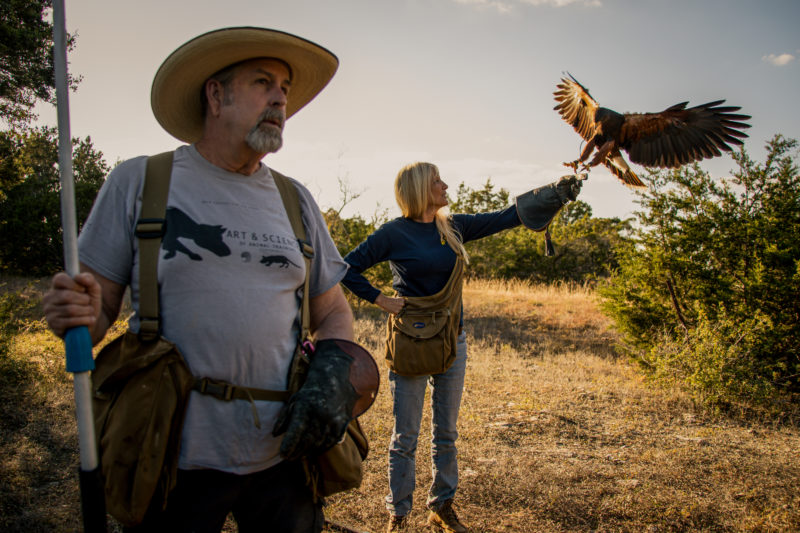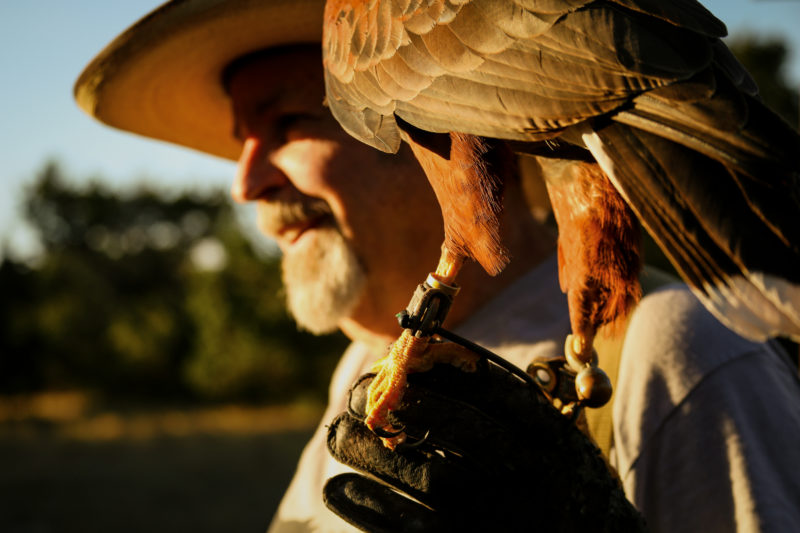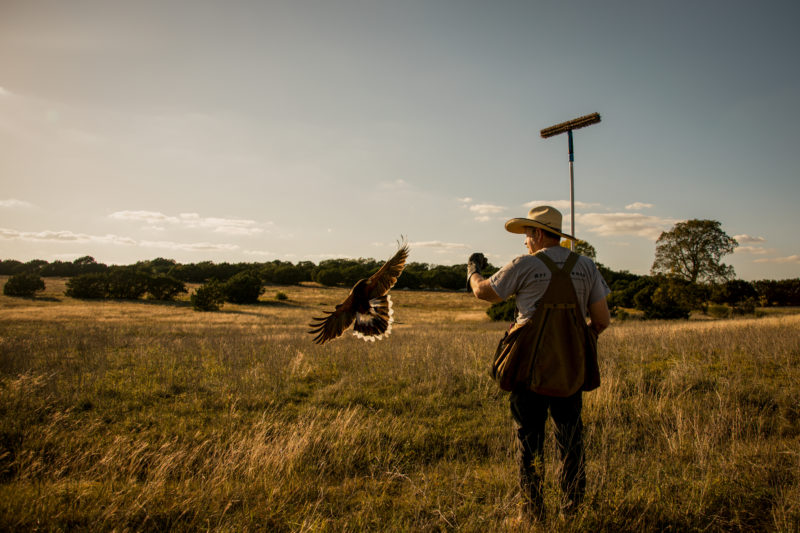Falconry Soars in Texas
By Sumaiya Malik
Reporting Texas

Al and Tamara Kordowski (left to right) fly their two hawks on Alexander Ranch in Dripping Springs, Texas, on Nov. 7, 2020. The two hawks are from a species known as Harris’s Hawks. The hawks are in their eighth hunting season with the Kordowskis. Chloe Bertrand/Reporting Texas
DRIPPING SPRINGS — “Flight!” Al Kordowski exclaimed as he and wife Tamara Kordowski ran toward the bushes on the grassy, yellow ranchland. Their two hawks zeroed in on a tiny bird that had flown out of the bushes by a grove of cedar trees. The raptors, with razor-sharp distance vision, were in hot pursuit of prey.
“It got away,” Tamara hollered, calling the hawks to an 8-foot pole resting on her pelvic bone. The other end pointed skyward. The pole provided a perch where Pierce and Lieca, a pair of Harris’s Hawks, could scan for prey.
The Kordowskis — Al is 65, Tamara 60 — have practiced falconry for more than 30 years. The North American Falconers Association defines falconry as “the taking of wild quarry in its natural state and habitat by means of a trained raptor.”
Megan Nelson, falconry permit coordinator at Texas Parks and Wildlife, says falconry is a niche sport, but the state has seen an uptick in applications for falconry permits. “We have an average of 14 new applicants each year,” Nelson said, but “in 2019 that number increased to 27.” There are 389 licensed falconers in Texas, Nelson added.
The permit process includes an initial exam and years of training. A falconer starts off with an apprenticeship permit and can progress to general, then master falconer. General and master falconers can obtain birds through breeding programs that charge from several hundred to several thousand dollars per bird, Corey Loeke, director-at-large of the Texas Hawking Association, said.
Al Kordowski is a master falconer. “I always feel like I’m planning with them,” Al said. “The hawks are panning the field,” Al explained as the birds bobbed their heads, their bright yellow curved beaks moving left to right. Suddenly, the hawks were off again, one ahead of the other in search of prey.
The Kordowskis, who live in Dripping Springs, moved to Texas in 2011. They spent most of the previous four decades in Orlando, Fla., where Al worked as an animal trainer at SeaWorld. He helped replace punishment and restraining training procedures with positive training, Kordowski said.

Al Kordowski’s gloved hand holds one of his Harris’s Hawks at Alexander Ranch in Dripping Springs, Texas, on Nov. 7, 2020. The Kordowski’s two hawks, Pierce and Leica, share a backyard with dogs, parrots and a tortoise named Kramer. Chloe Bertrand/Reporting Texas
Matt Reidy, 38, is the southern director of the Texas Hawking Association, a nonprofit organization that promotes falconry, and a master falconer and wildlife biologist for the Texas Parks and Wildlife Department. He has practiced falconry for 22 years.
Reidy uses falcons to hunt ducks. “I let the falcon go and fly up higher in the sky several hundred feet or more above a pond that has ducks on it. Then I flush those ducks out and the falcon goes into a stoop, a power dive, folds its wings and falls straight down to try to catch the duck,” he said.
“These birds of prey are generally not social animals. They don’t like to be petted like a dog or hang out with you,” Reidy said.
Hunting with the falcons may sometimes be gruesome, but falconers aren’t deterred. “It’s kind of refreshing to be out in nature now and seeing them hunt like they would if you weren’t there,” said Amy Forster, a registered nurse and a general falconer from Katy.
Forster, 43, hunts with her 5-year-old captive-bred Harris’s hawk named Easy. “My job is to kind of walk along and wrestle the bushes and shake the brush and get something to flush so that he can hunt. And he becomes accustomed to that,” Forster said. “He has a role, and I have a role.”
The sport has its detractors, including People for the Ethical Treatment of Animals. “Breeding raptors in captivity or taking them from their natural habitat, denying them a real life, and using them to experience killing small animals vicariously is a matter of domination, not protection,” PETA President Ingrid Newkirk said in an emailed statement.
Falconers say the sport is an act of nature that will happen with or without them.
“When we are hunting with the [hawks] they’re completely untethered. They can leave at any moment,” said Alyssa Hurley, 18, a general falconer from Tyler. “They could look, sit on a tree, turn around, look at me and say, ‘See ya!’ and fly off, and we never see that bird again.”
Falconers also argue that breeding falcons has saved some species from extinction. The success of repopulation programs led by falconers were responsible for the peregrine falcon being taken off the endangered species list in 1998, according to the U.S. Fish and Wildlife Service.
Alyssa and her father, Dennis Hurley, a retired political science professor at the University of Texas at Tyler and a master falconer, released Yuki, Alyssa’s red-tailed hawk, back into the wild in the spring. Alyssa was moving to Tarleton State University in Stephenville, for school. “He’s a very pretty bird, and I want him to make more babies,” Alyssa said.
“He went back to the wild the same way he came into my life, but now with more experience to survive,” Alyssa said.

Al Kordowski holds out a gloved hand for one of his hawks to land on at Alexander Ranch in Dripping Springs, Texas, on Nov. 7, 2020. Al and his wife Tamara Kordowski are passionate about hawk conservation and education, as well as about their own bonds with their two hawks. Chloe Bertrand/Reporting Texas
Birds of prey have up to 80% chance of dying in the wild before they reach their first birthday, Dennis Hurley said. Hatchlings face a hostile environment due to pesticides, moving vehicles and high-powered electric cables. Falconers sometimes take young birds from the wild, raise them in captivity, provide them medical care and eventually hunt with them, he said. After a few years, they are often released back into the wild as healthy adult birds, Hurley added.
For the Kordowskis, there’s nothing quite like watching the birds they trained in action.
“They’re doing their thing out there, and we’re just being lucky to be there at that moment to see it, you know, and to be able to bring it home and do it again,” Tamara Kordowski said.
An earlier version of this story incorrectly referred to Al Kordowski’s hawks as falcons. A reference to Al Kordowski feeding a rabbit leg to a hawk has also been removed.